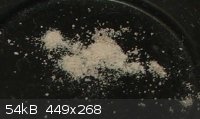Mirage
Harmless

Posts: 49
Registered: 26-1-2012
Location: Canada
Member Is Offline
Mood: Superheated
|
|
Yellow unknown insoluble compound! What is it?
So I this morning I was making antimony metal, with Sb2S3, HCl, and Zn and as I was filtering the solution of ZnCl2, Sb, and small amount of unreacted
HCl, a yellow precipitate formed in the receiving flask as I was washing the funnel with a squirt bottle after filtration. What is this? The funnel
may have had a few possible contaminants such as, Cu(NO3)2, Zn(NO3)2, Zn, and Cu. Could any of these have reacted with Sb, Sb2S3, Sb2Cl3, Zn, ZnCl2,
or HCl? These are all the possible contaminants other than anything in the tap water.
Thanks for your help
Mirage
[Edited on 12-2-2012 by Mirage]
|
|
|
ScienceSquirrel
International Hazard
    
Posts: 1863
Registered: 18-6-2008
Location: Brittany
Member Is Offline
Mood: Dogs are pets but cats are little furry humans with four feet and self determination! 
|
|
You could give us a bit more of a clue!
A picture would be nice.
Have you tried heating it, alone or with acids or alkalis?
|
|
|
Mirage
Harmless

Posts: 49
Registered: 26-1-2012
Location: Canada
Member Is Offline
Mood: Superheated
|
|
Sorry! I don't even know what it is! After I swirled the receiving beaker, the compound dissolved! It sort of formed an upper layer, like polar and
non polar compounds. Unfortunately I do not have a picture as the receiving flask was dumped down into the disposal drain.
Mirage
|
|
|
Poppy
Hazard to Others
  
Posts: 294
Registered: 3-11-2011
Member Is Offline
Mood: † chemical zombie
|
|
Shouldn't you had to get rid of the H2S and whether sulphur which was left in the vessel before preceding to put Zn in it?
|
|
|
LanthanumK
Hazard to Others
  
Posts: 298
Registered: 20-5-2011
Location: New Jersey
Member Is Offline
Mood: No Mood
|
|
Formation of a precipitate is common when soluble antimony compounds are reacted with water, but the precipitate of antimony oxychloride, which is an
off white, is not soluble in water. Are you sure the precipitate did not just get colloidal when swirled? I've had that happen with boron already; it
appears that the boron dissolves upon agitation, but upon standing for a long period of time, the boron falls out again.

[Edited on 13-2-2012 by LanthanumK]
hibernating...
|
|
|
Mirage
Harmless

Posts: 49
Registered: 26-1-2012
Location: Canada
Member Is Offline
Mood: Superheated
|
|
Possibly. The compound looks like that photo. So it could be Antimony Oxychloride. But this compound that formed was like a real yellow. Like bananas,
maybe a little darker. Overall, I think it's probably going to have been the Oxychloride.
Thanks for the help!
Mirage
Quote: Originally posted by LanthanumK  | Formation of a precipitate is common when soluble antimony compounds are reacted with water, but the precipitate of antimony oxychloride, which is an
off white, is not soluble in water. Are you sure the precipitate did not just get colloidal when swirled? I've had that happen with boron already; it
appears that the boron dissolves upon agitation, but upon standing for a long period of time, the boron falls out again.
[Edited on 13-2-2012 by LanthanumK] |
|
|
|
Mirage
Harmless

Posts: 49
Registered: 26-1-2012
Location: Canada
Member Is Offline
Mood: Superheated
|
|
Well since H2S is a gas, it was not present in the reaction vessel when I added the zinc. No elemental sulfur was ever evolved in the reaction, so
there is no chance of Sulfur contamination. Is this what you mean?
Mirag
Quote: Originally posted by Poppy  | | Shouldn't you had to get rid of the H2S and whether sulphur which was left in the vessel before preceding to put Zn in it? |
|
|
|